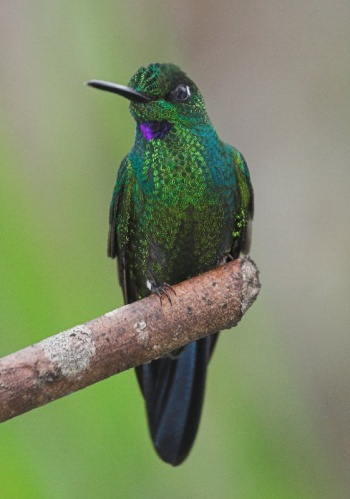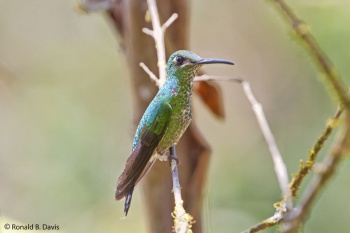- Heliodoxa jacula
Identification
12–13 cm
Iridescent green plumage. The male has a (purplish) blue throat spot (often difficult to see). Male bill medium length but very straight with minimal curvature. Feathering extends forwards from the bill base. It frequently raises these upper feathers—those from the upper mandible to just in front of the eye. Female bill generally slightly curved. Both sexes have white post-ocular spot. The female has white underside with green spots in streaks, and prominent white malar stripe. Juvenile has rufous chin and malar. Both sexes shows a forked tail, male more than female, and with white tail corners in female; tail colour varies with location in males.
Distribution
Found in Central America and South America: Costa Rica, Panama, Colombia and Ecuador.
Taxonomy
Subspecies
Three subspecies are recognized[1]:
- H. j. henryi:
- Costa Rica and western Panama
- H. j. jacula:
- H. j. jamersoni:
Habitat
Wet subtropical and montane forests and forest edges. Observed at heights around 6000 ft.
Behaviour
Diet
Their diet consists mostly of nectar taken from long flower bracts from vines such as Marcgravia. Regularly seen at feeders.
Vocalisation
A repetitive kyew.
References
- Clements, J. F., T. S. Schulenberg, M. J. Iliff, D. Roberson, T. A. Fredericks, B. L. Sullivan, and C. L. Wood. 2014. The eBird/Clements checklist of birds of the world: Version 6.9., with updates to August 2014. Downloaded from http://www.birds.cornell.edu/clementschecklist/download/
- Avibase
- BF Member observations
- Garrigues and Dean 2007. The birds of Costa Rica - a field guide. Cornell University Press. ISBN 978-0-8014-7373-9
- Ridgely & Gwynne 1989. Birds of Panama. Princeton Paperbacks. ISBN 0691025126
- Handbook of the Birds of the World Alive (retrieved December 2014)
Recommended Citation
- BirdForum Opus contributors. (2024) Green-crowned Brilliant. In: BirdForum, the forum for wild birds and birding. Retrieved 26 April 2024 from https://www.birdforum.net/opus/Green-crowned_Brilliant
Photo © by Jim Crosswell
Finca Oro, Costa Rica, January 2009Juvenile
Photo © by obasanmi
Costa Rica, September 2009
Click on photos to enlarge
External Links
GSearch checked for 2020 platform.1








